Evaluating Management and Leadership in ASDA's Operations
VerifiedAdded on 2020/01/07
|17
|4438
|1216
Report
AI Summary
This report analyzes the roles of managers and leaders within ASDA, a major supermarket chain. It begins by differentiating between the key functions of a manager and a leader, exploring their distinct characteristics and responsibilities. The report then examines how managers and leaders navigate various organizational situations, including conflict resolution and employee motivation, and discusses the application of contemporary management theories, such as classical and bureaucratic leadership, to support organizational growth. Furthermore, the report delves into the role of leaders and managers in managing business operations, outlining key approaches to operations management and evaluating the factors that influence operational decision-making. The findings highlight the importance of effective communication, conflict resolution, and the implementation of appropriate management theories to optimize organizational performance. The report concludes with recommendations for ASDA, emphasizing the need for a more collaborative organizational structure and the importance of addressing communication gaps to enhance overall operational efficiency and employee satisfaction.
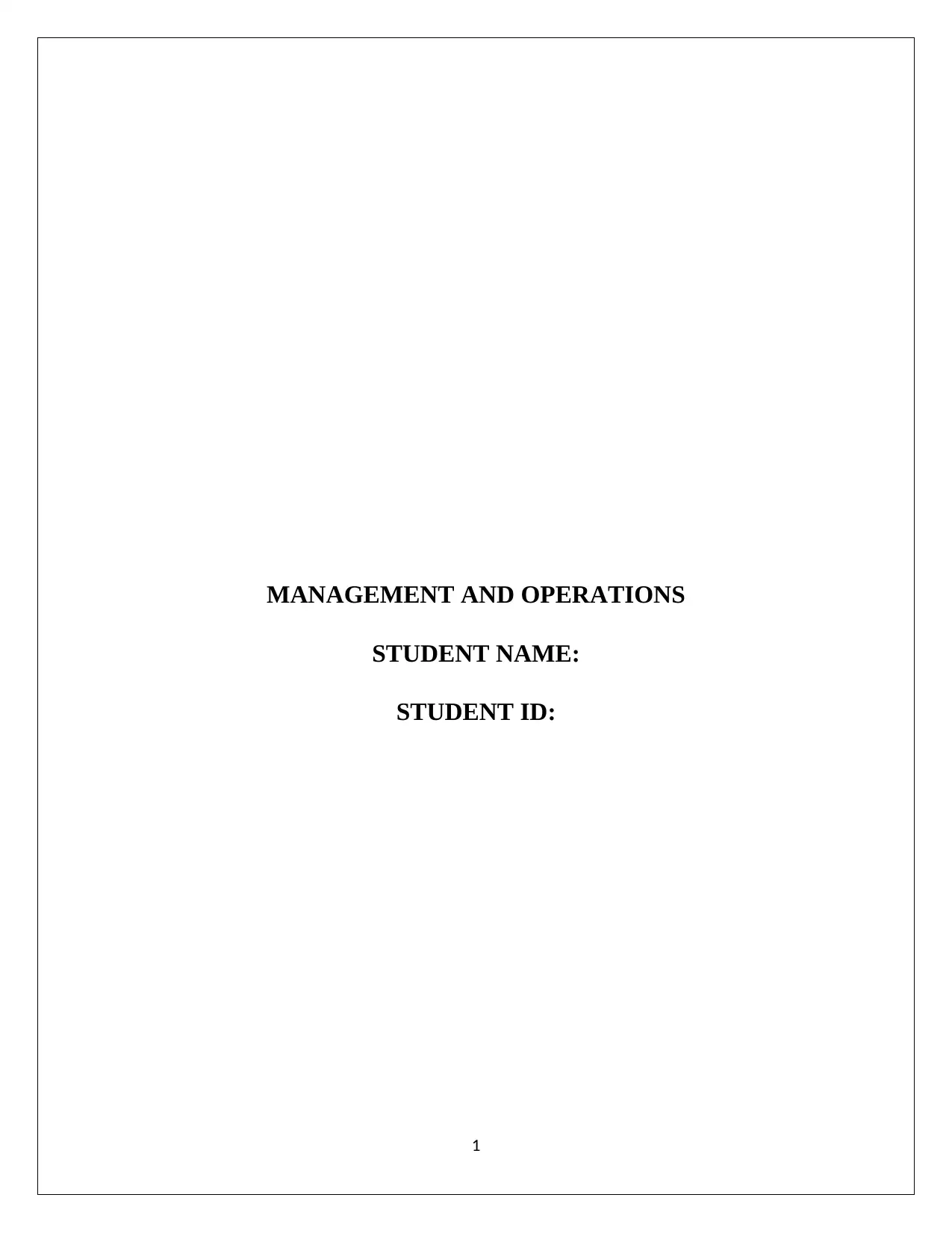
MANAGEMENT AND OPERATIONS
STUDENT NAME:
STUDENT ID:
1
STUDENT NAME:
STUDENT ID:
1
Paraphrase This Document
Need a fresh take? Get an instant paraphrase of this document with our AI Paraphraser
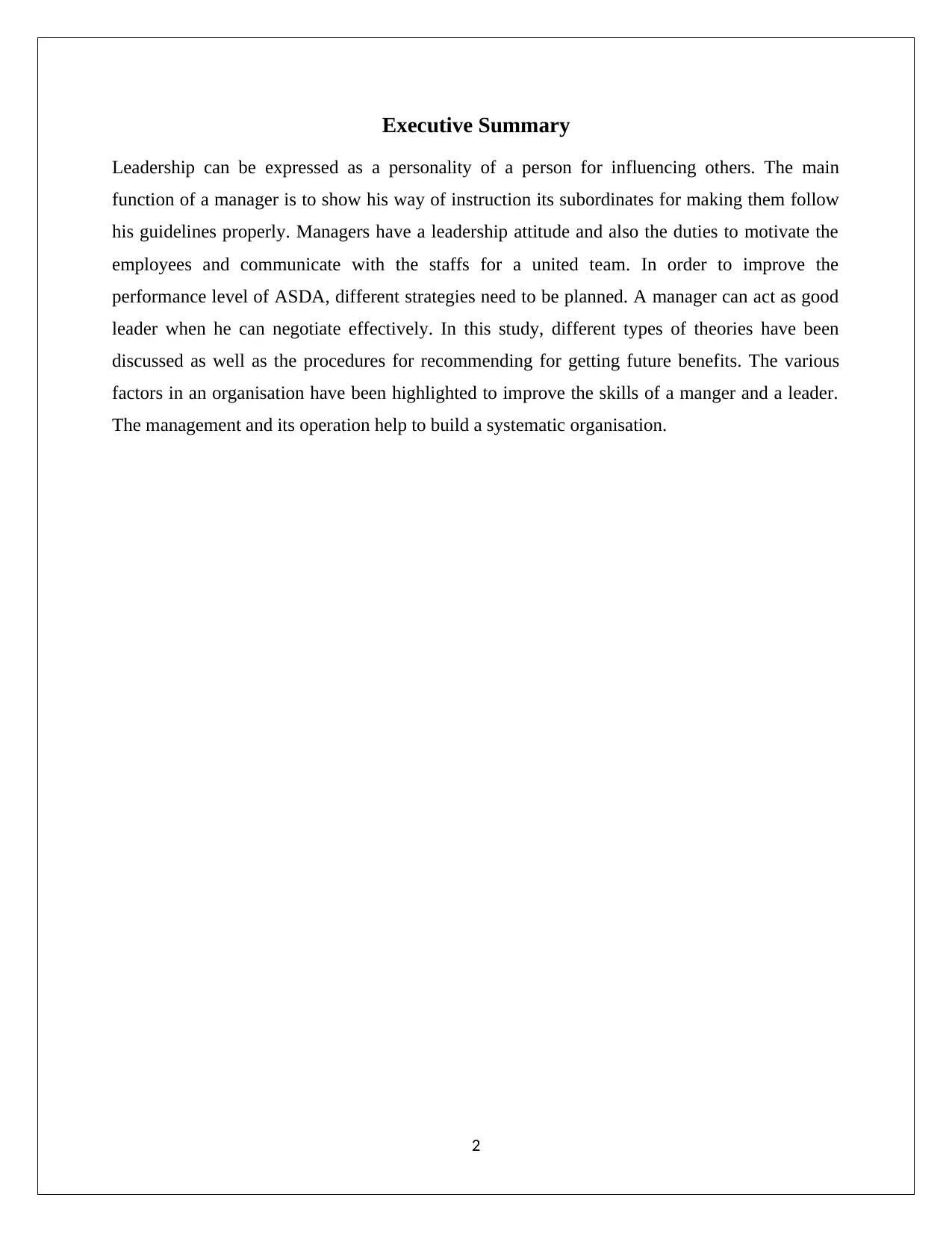
Executive Summary
Leadership can be expressed as a personality of a person for influencing others. The main
function of a manager is to show his way of instruction its subordinates for making them follow
his guidelines properly. Managers have a leadership attitude and also the duties to motivate the
employees and communicate with the staffs for a united team. In order to improve the
performance level of ASDA, different strategies need to be planned. A manager can act as good
leader when he can negotiate effectively. In this study, different types of theories have been
discussed as well as the procedures for recommending for getting future benefits. The various
factors in an organisation have been highlighted to improve the skills of a manger and a leader.
The management and its operation help to build a systematic organisation.
2
Leadership can be expressed as a personality of a person for influencing others. The main
function of a manager is to show his way of instruction its subordinates for making them follow
his guidelines properly. Managers have a leadership attitude and also the duties to motivate the
employees and communicate with the staffs for a united team. In order to improve the
performance level of ASDA, different strategies need to be planned. A manager can act as good
leader when he can negotiate effectively. In this study, different types of theories have been
discussed as well as the procedures for recommending for getting future benefits. The various
factors in an organisation have been highlighted to improve the skills of a manger and a leader.
The management and its operation help to build a systematic organisation.
2
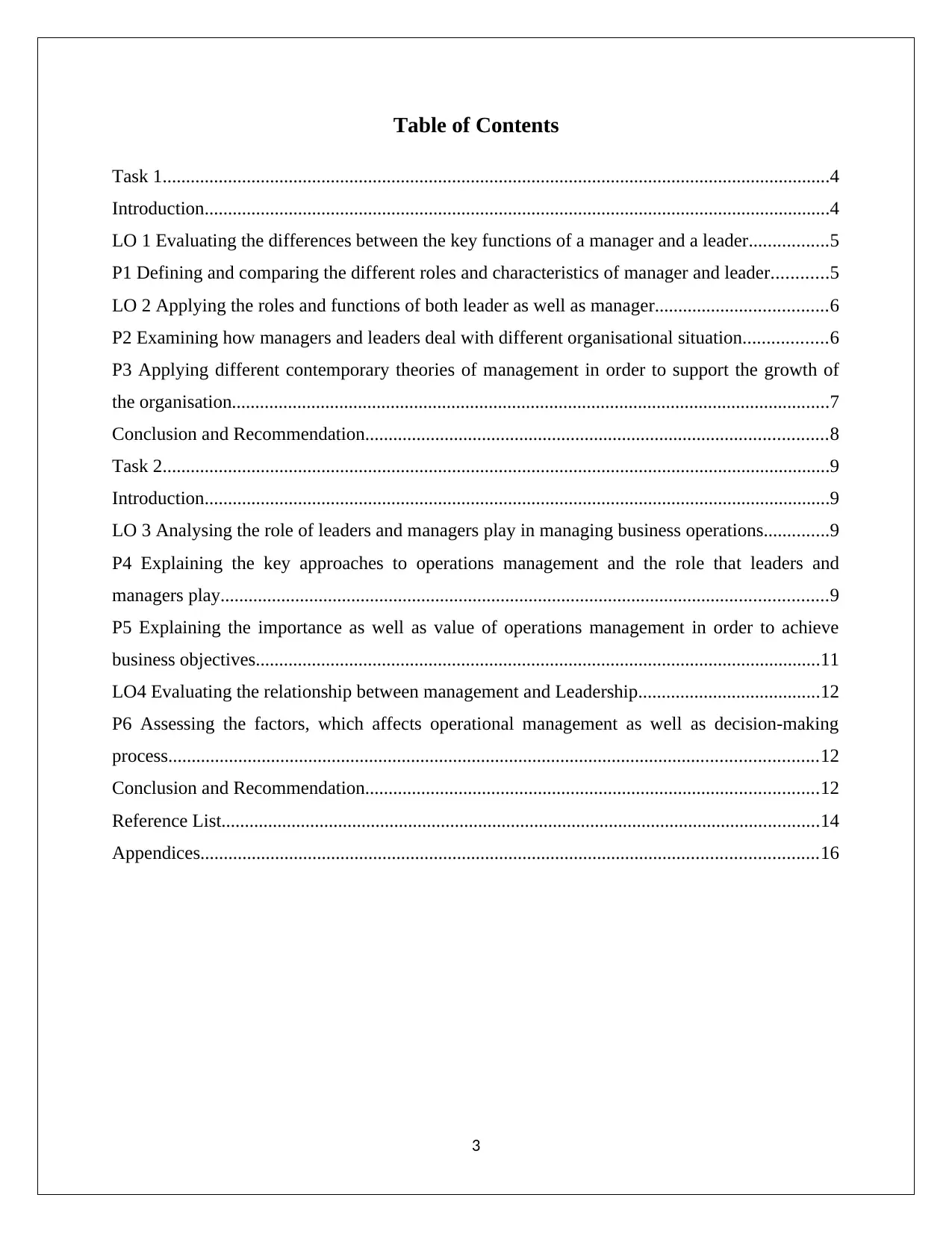
Table of Contents
Task 1...............................................................................................................................................4
Introduction......................................................................................................................................4
LO 1 Evaluating the differences between the key functions of a manager and a leader.................5
P1 Defining and comparing the different roles and characteristics of manager and leader............5
LO 2 Applying the roles and functions of both leader as well as manager.....................................6
P2 Examining how managers and leaders deal with different organisational situation..................6
P3 Applying different contemporary theories of management in order to support the growth of
the organisation................................................................................................................................7
Conclusion and Recommendation...................................................................................................8
Task 2...............................................................................................................................................9
Introduction......................................................................................................................................9
LO 3 Analysing the role of leaders and managers play in managing business operations..............9
P4 Explaining the key approaches to operations management and the role that leaders and
managers play..................................................................................................................................9
P5 Explaining the importance as well as value of operations management in order to achieve
business objectives.........................................................................................................................11
LO4 Evaluating the relationship between management and Leadership.......................................12
P6 Assessing the factors, which affects operational management as well as decision-making
process...........................................................................................................................................12
Conclusion and Recommendation.................................................................................................12
Reference List................................................................................................................................14
Appendices....................................................................................................................................16
3
Task 1...............................................................................................................................................4
Introduction......................................................................................................................................4
LO 1 Evaluating the differences between the key functions of a manager and a leader.................5
P1 Defining and comparing the different roles and characteristics of manager and leader............5
LO 2 Applying the roles and functions of both leader as well as manager.....................................6
P2 Examining how managers and leaders deal with different organisational situation..................6
P3 Applying different contemporary theories of management in order to support the growth of
the organisation................................................................................................................................7
Conclusion and Recommendation...................................................................................................8
Task 2...............................................................................................................................................9
Introduction......................................................................................................................................9
LO 3 Analysing the role of leaders and managers play in managing business operations..............9
P4 Explaining the key approaches to operations management and the role that leaders and
managers play..................................................................................................................................9
P5 Explaining the importance as well as value of operations management in order to achieve
business objectives.........................................................................................................................11
LO4 Evaluating the relationship between management and Leadership.......................................12
P6 Assessing the factors, which affects operational management as well as decision-making
process...........................................................................................................................................12
Conclusion and Recommendation.................................................................................................12
Reference List................................................................................................................................14
Appendices....................................................................................................................................16
3
⊘ This is a preview!⊘
Do you want full access?
Subscribe today to unlock all pages.

Trusted by 1+ million students worldwide
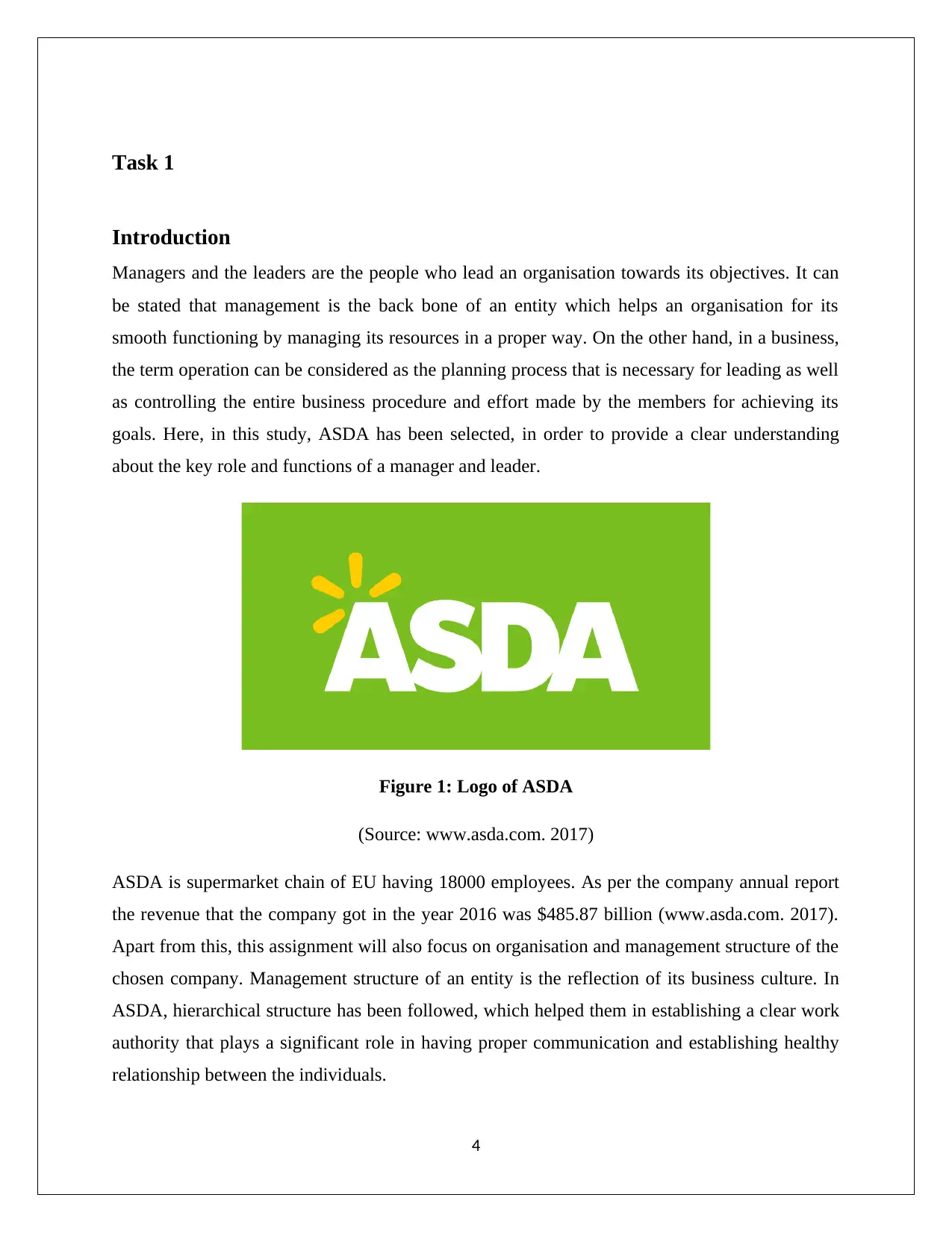
Task 1
Introduction
Managers and the leaders are the people who lead an organisation towards its objectives. It can
be stated that management is the back bone of an entity which helps an organisation for its
smooth functioning by managing its resources in a proper way. On the other hand, in a business,
the term operation can be considered as the planning process that is necessary for leading as well
as controlling the entire business procedure and effort made by the members for achieving its
goals. Here, in this study, ASDA has been selected, in order to provide a clear understanding
about the key role and functions of a manager and leader.
Figure 1: Logo of ASDA
(Source: www.asda.com. 2017)
ASDA is supermarket chain of EU having 18000 employees. As per the company annual report
the revenue that the company got in the year 2016 was $485.87 billion (www.asda.com. 2017).
Apart from this, this assignment will also focus on organisation and management structure of the
chosen company. Management structure of an entity is the reflection of its business culture. In
ASDA, hierarchical structure has been followed, which helped them in establishing a clear work
authority that plays a significant role in having proper communication and establishing healthy
relationship between the individuals.
4
Introduction
Managers and the leaders are the people who lead an organisation towards its objectives. It can
be stated that management is the back bone of an entity which helps an organisation for its
smooth functioning by managing its resources in a proper way. On the other hand, in a business,
the term operation can be considered as the planning process that is necessary for leading as well
as controlling the entire business procedure and effort made by the members for achieving its
goals. Here, in this study, ASDA has been selected, in order to provide a clear understanding
about the key role and functions of a manager and leader.
Figure 1: Logo of ASDA
(Source: www.asda.com. 2017)
ASDA is supermarket chain of EU having 18000 employees. As per the company annual report
the revenue that the company got in the year 2016 was $485.87 billion (www.asda.com. 2017).
Apart from this, this assignment will also focus on organisation and management structure of the
chosen company. Management structure of an entity is the reflection of its business culture. In
ASDA, hierarchical structure has been followed, which helped them in establishing a clear work
authority that plays a significant role in having proper communication and establishing healthy
relationship between the individuals.
4
Paraphrase This Document
Need a fresh take? Get an instant paraphrase of this document with our AI Paraphraser
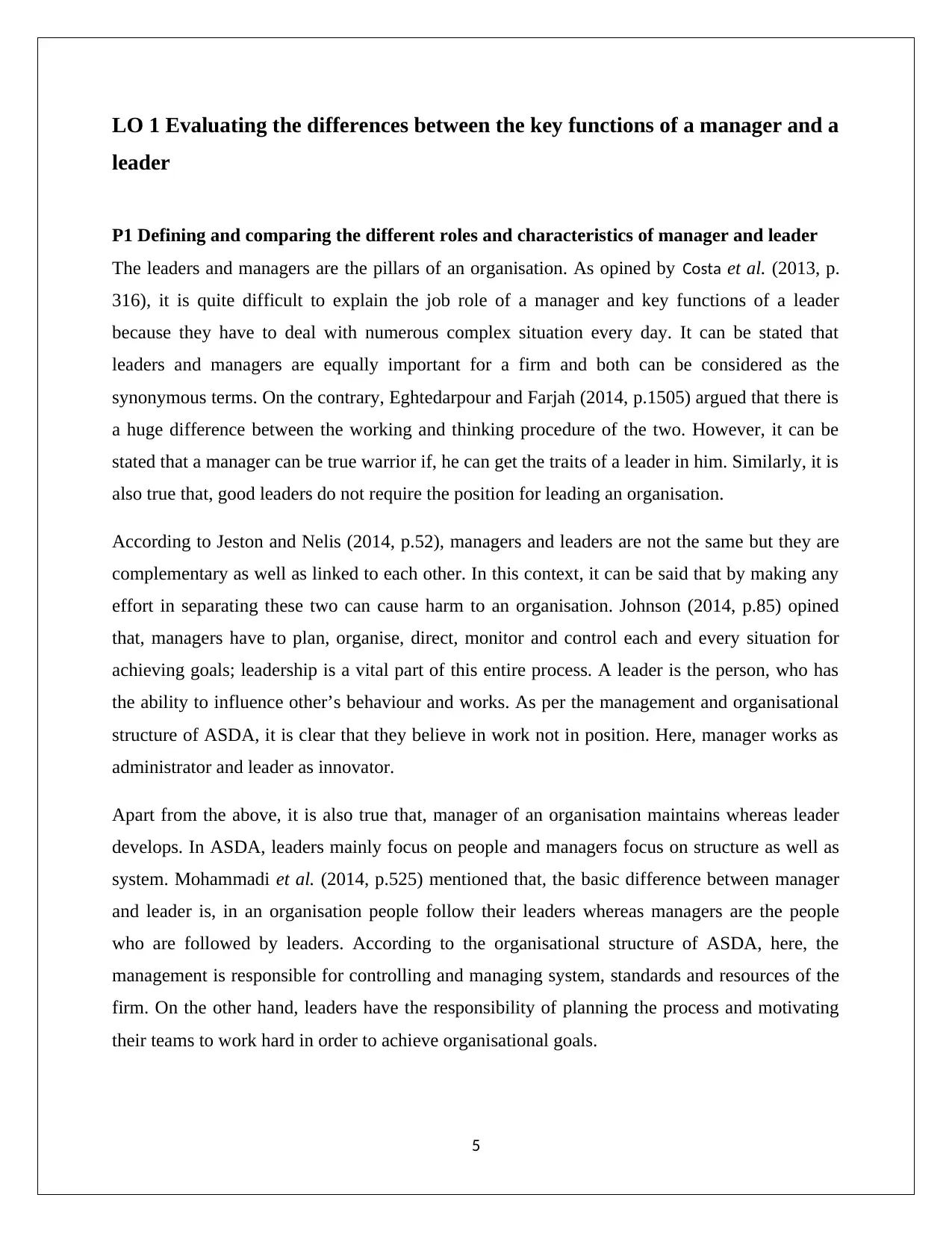
LO 1 Evaluating the differences between the key functions of a manager and a
leader
P1 Defining and comparing the different roles and characteristics of manager and leader
The leaders and managers are the pillars of an organisation. As opined by Costa et al. (2013, p.
316), it is quite difficult to explain the job role of a manager and key functions of a leader
because they have to deal with numerous complex situation every day. It can be stated that
leaders and managers are equally important for a firm and both can be considered as the
synonymous terms. On the contrary, Eghtedarpour and Farjah (2014, p.1505) argued that there is
a huge difference between the working and thinking procedure of the two. However, it can be
stated that a manager can be true warrior if, he can get the traits of a leader in him. Similarly, it is
also true that, good leaders do not require the position for leading an organisation.
According to Jeston and Nelis (2014, p.52), managers and leaders are not the same but they are
complementary as well as linked to each other. In this context, it can be said that by making any
effort in separating these two can cause harm to an organisation. Johnson (2014, p.85) opined
that, managers have to plan, organise, direct, monitor and control each and every situation for
achieving goals; leadership is a vital part of this entire process. A leader is the person, who has
the ability to influence other’s behaviour and works. As per the management and organisational
structure of ASDA, it is clear that they believe in work not in position. Here, manager works as
administrator and leader as innovator.
Apart from the above, it is also true that, manager of an organisation maintains whereas leader
develops. In ASDA, leaders mainly focus on people and managers focus on structure as well as
system. Mohammadi et al. (2014, p.525) mentioned that, the basic difference between manager
and leader is, in an organisation people follow their leaders whereas managers are the people
who are followed by leaders. According to the organisational structure of ASDA, here, the
management is responsible for controlling and managing system, standards and resources of the
firm. On the other hand, leaders have the responsibility of planning the process and motivating
their teams to work hard in order to achieve organisational goals.
5
leader
P1 Defining and comparing the different roles and characteristics of manager and leader
The leaders and managers are the pillars of an organisation. As opined by Costa et al. (2013, p.
316), it is quite difficult to explain the job role of a manager and key functions of a leader
because they have to deal with numerous complex situation every day. It can be stated that
leaders and managers are equally important for a firm and both can be considered as the
synonymous terms. On the contrary, Eghtedarpour and Farjah (2014, p.1505) argued that there is
a huge difference between the working and thinking procedure of the two. However, it can be
stated that a manager can be true warrior if, he can get the traits of a leader in him. Similarly, it is
also true that, good leaders do not require the position for leading an organisation.
According to Jeston and Nelis (2014, p.52), managers and leaders are not the same but they are
complementary as well as linked to each other. In this context, it can be said that by making any
effort in separating these two can cause harm to an organisation. Johnson (2014, p.85) opined
that, managers have to plan, organise, direct, monitor and control each and every situation for
achieving goals; leadership is a vital part of this entire process. A leader is the person, who has
the ability to influence other’s behaviour and works. As per the management and organisational
structure of ASDA, it is clear that they believe in work not in position. Here, manager works as
administrator and leader as innovator.
Apart from the above, it is also true that, manager of an organisation maintains whereas leader
develops. In ASDA, leaders mainly focus on people and managers focus on structure as well as
system. Mohammadi et al. (2014, p.525) mentioned that, the basic difference between manager
and leader is, in an organisation people follow their leaders whereas managers are the people
who are followed by leaders. According to the organisational structure of ASDA, here, the
management is responsible for controlling and managing system, standards and resources of the
firm. On the other hand, leaders have the responsibility of planning the process and motivating
their teams to work hard in order to achieve organisational goals.
5

LO 2 Applying the roles and functions of both leader as well as manager
P2 Examining how managers and leaders deal with different organisational situation
According to Alexander (2013, p.1699), conflict is a part of everyone’s life. It is also part of day-
to-day business performer like ASDA. Conflict is inevitable when a person is spending so much
time with the same people. A leader has to deal with such situation every day. They have to be
dedicated towards their work more because it is their duty to manage all the difficult situations
occurred in the workplace regularly. Leaders and the managers have to meet the deadlines; they
have to handle the excessive work pressure. Apart from this, they are also liable for maintaining
the productivity and motivating people for better performance and increasing productivity of an
organisation. In order to get respect, managers and leaders have to act responsibly. As mentioned
by Ozturk et al. (2013, p.701), in the difficult situations like strike for excessive work load or
remuneration issue, they establish the facts first to understand the reason behind this occurrence.
Luo et al. (2015, p.536) stated that, by asking questions or communicating properly it is possible
for a person to resolve any kind of issue in workplace. On the other hand, Witt et al. (2013, p.85)
opined that leaders must be a good listeners because this is the way by which proper connection
can be made between the top management with their subordinates.
In recent days, redundancy and restructuring has become stressful and difficult for the managers
and the leaders Varley (2014, p.45). According to the managers of ASDA, it is one of the
toughest changes that a leader has to deal with. For handling such situation, managers and the
leaders have to work together for decision making and motivating employees to support
organisational decisions. They have to provide proper clarification for redundancy to the existing
employee. They have to discuss about the compensation to their subordinates that they have
provided to the ex-staffs. Hill and Hill (2011, p.15) mentioned that, effective crisis management
is vital for today’s competitive business environment. The managers and leaders have to deal
with various issues such as work place accident, employee retention. They take care of these
kinds of situation by great are because they know how to manage this emotional impacts. Apart
from this, by providing honest judgement for any situation they can fix the occurrence of the
6
P2 Examining how managers and leaders deal with different organisational situation
According to Alexander (2013, p.1699), conflict is a part of everyone’s life. It is also part of day-
to-day business performer like ASDA. Conflict is inevitable when a person is spending so much
time with the same people. A leader has to deal with such situation every day. They have to be
dedicated towards their work more because it is their duty to manage all the difficult situations
occurred in the workplace regularly. Leaders and the managers have to meet the deadlines; they
have to handle the excessive work pressure. Apart from this, they are also liable for maintaining
the productivity and motivating people for better performance and increasing productivity of an
organisation. In order to get respect, managers and leaders have to act responsibly. As mentioned
by Ozturk et al. (2013, p.701), in the difficult situations like strike for excessive work load or
remuneration issue, they establish the facts first to understand the reason behind this occurrence.
Luo et al. (2015, p.536) stated that, by asking questions or communicating properly it is possible
for a person to resolve any kind of issue in workplace. On the other hand, Witt et al. (2013, p.85)
opined that leaders must be a good listeners because this is the way by which proper connection
can be made between the top management with their subordinates.
In recent days, redundancy and restructuring has become stressful and difficult for the managers
and the leaders Varley (2014, p.45). According to the managers of ASDA, it is one of the
toughest changes that a leader has to deal with. For handling such situation, managers and the
leaders have to work together for decision making and motivating employees to support
organisational decisions. They have to provide proper clarification for redundancy to the existing
employee. They have to discuss about the compensation to their subordinates that they have
provided to the ex-staffs. Hill and Hill (2011, p.15) mentioned that, effective crisis management
is vital for today’s competitive business environment. The managers and leaders have to deal
with various issues such as work place accident, employee retention. They take care of these
kinds of situation by great are because they know how to manage this emotional impacts. Apart
from this, by providing honest judgement for any situation they can fix the occurrence of the
6
⊘ This is a preview!⊘
Do you want full access?
Subscribe today to unlock all pages.

Trusted by 1+ million students worldwide
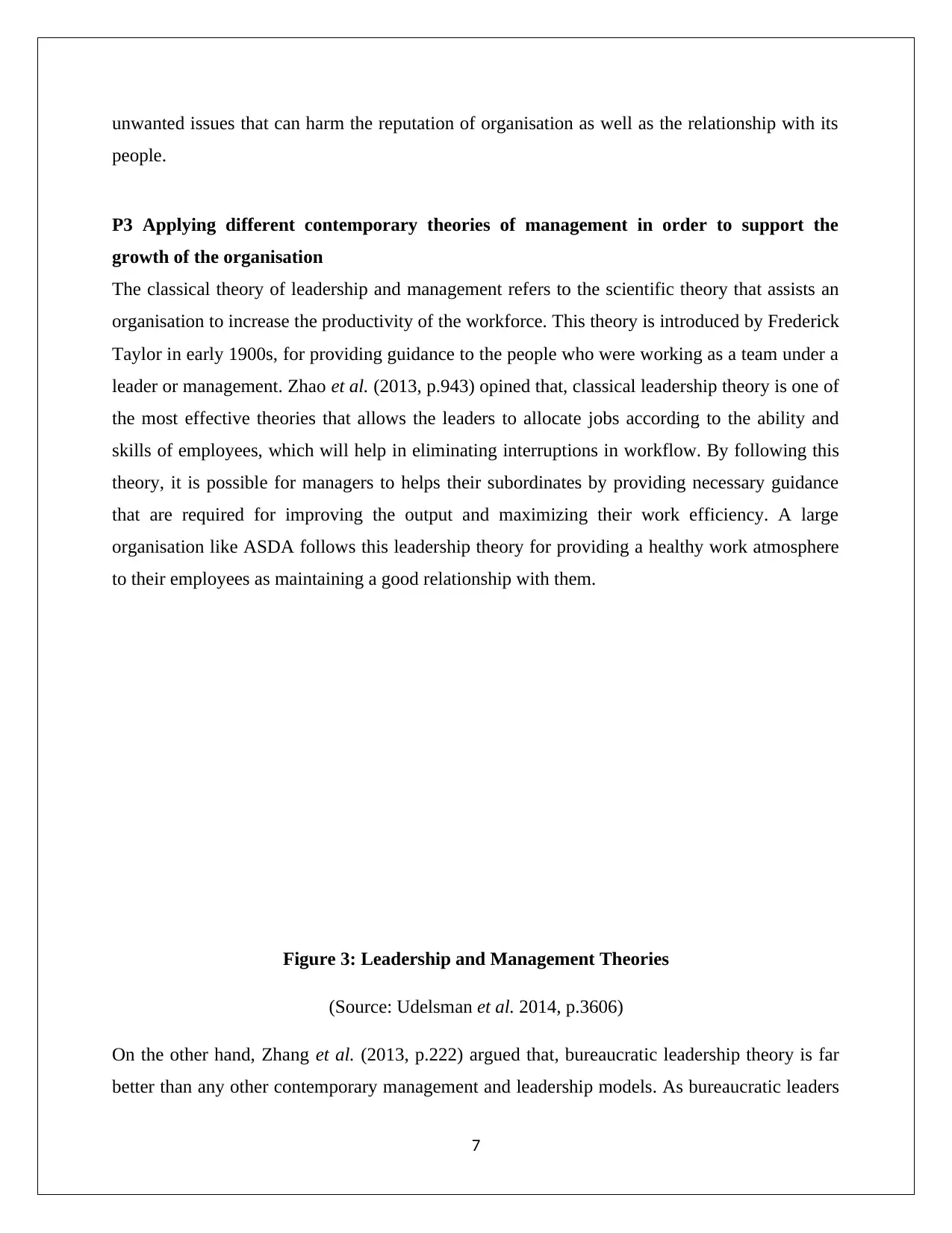
unwanted issues that can harm the reputation of organisation as well as the relationship with its
people.
P3 Applying different contemporary theories of management in order to support the
growth of the organisation
The classical theory of leadership and management refers to the scientific theory that assists an
organisation to increase the productivity of the workforce. This theory is introduced by Frederick
Taylor in early 1900s, for providing guidance to the people who were working as a team under a
leader or management. Zhao et al. (2013, p.943) opined that, classical leadership theory is one of
the most effective theories that allows the leaders to allocate jobs according to the ability and
skills of employees, which will help in eliminating interruptions in workflow. By following this
theory, it is possible for managers to helps their subordinates by providing necessary guidance
that are required for improving the output and maximizing their work efficiency. A large
organisation like ASDA follows this leadership theory for providing a healthy work atmosphere
to their employees as maintaining a good relationship with them.
Figure 3: Leadership and Management Theories
(Source: Udelsman et al. 2014, p.3606)
On the other hand, Zhang et al. (2013, p.222) argued that, bureaucratic leadership theory is far
better than any other contemporary management and leadership models. As bureaucratic leaders
7
people.
P3 Applying different contemporary theories of management in order to support the
growth of the organisation
The classical theory of leadership and management refers to the scientific theory that assists an
organisation to increase the productivity of the workforce. This theory is introduced by Frederick
Taylor in early 1900s, for providing guidance to the people who were working as a team under a
leader or management. Zhao et al. (2013, p.943) opined that, classical leadership theory is one of
the most effective theories that allows the leaders to allocate jobs according to the ability and
skills of employees, which will help in eliminating interruptions in workflow. By following this
theory, it is possible for managers to helps their subordinates by providing necessary guidance
that are required for improving the output and maximizing their work efficiency. A large
organisation like ASDA follows this leadership theory for providing a healthy work atmosphere
to their employees as maintaining a good relationship with them.
Figure 3: Leadership and Management Theories
(Source: Udelsman et al. 2014, p.3606)
On the other hand, Zhang et al. (2013, p.222) argued that, bureaucratic leadership theory is far
better than any other contemporary management and leadership models. As bureaucratic leaders
7
Paraphrase This Document
Need a fresh take? Get an instant paraphrase of this document with our AI Paraphraser
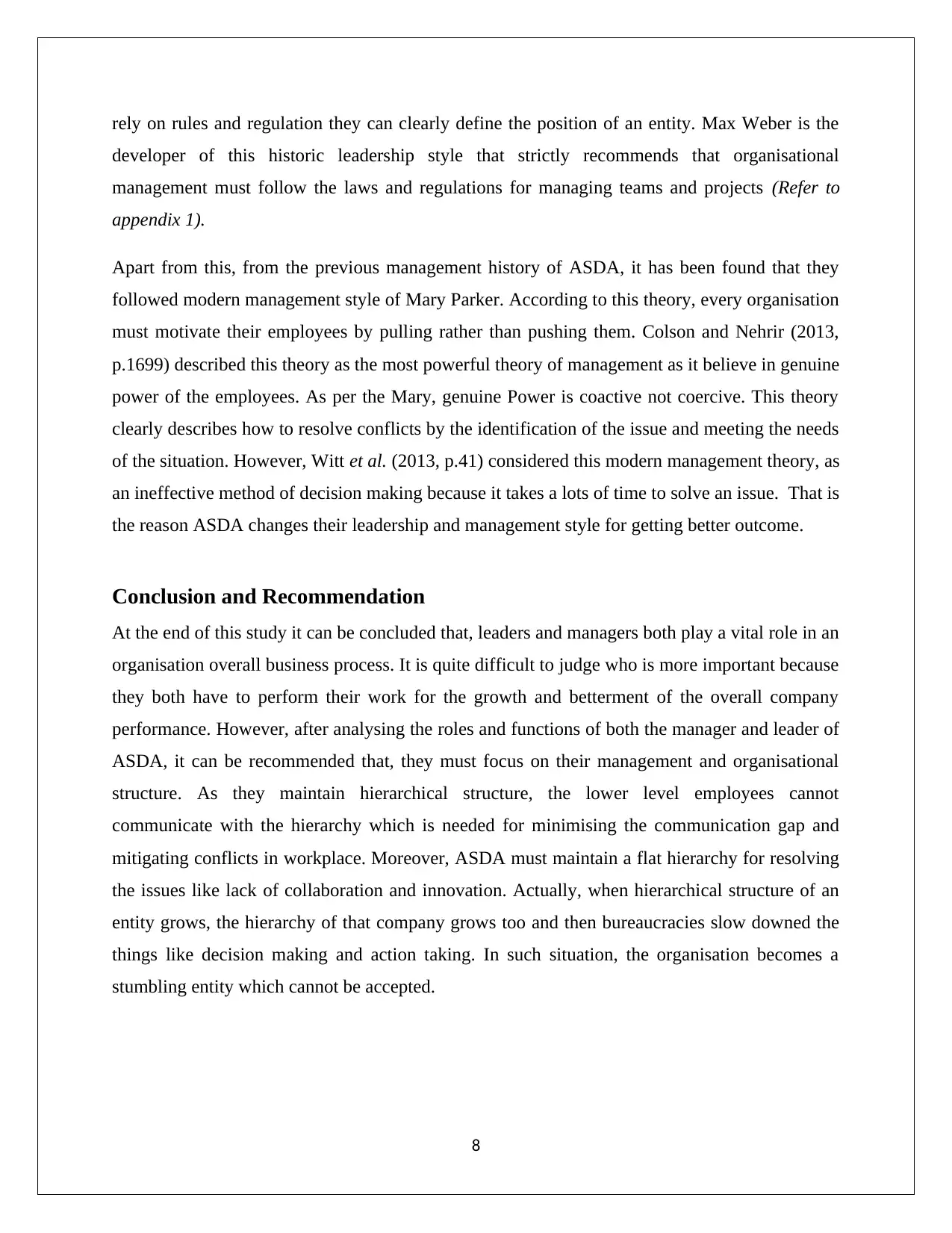
rely on rules and regulation they can clearly define the position of an entity. Max Weber is the
developer of this historic leadership style that strictly recommends that organisational
management must follow the laws and regulations for managing teams and projects (Refer to
appendix 1).
Apart from this, from the previous management history of ASDA, it has been found that they
followed modern management style of Mary Parker. According to this theory, every organisation
must motivate their employees by pulling rather than pushing them. Colson and Nehrir (2013,
p.1699) described this theory as the most powerful theory of management as it believe in genuine
power of the employees. As per the Mary, genuine Power is coactive not coercive. This theory
clearly describes how to resolve conflicts by the identification of the issue and meeting the needs
of the situation. However, Witt et al. (2013, p.41) considered this modern management theory, as
an ineffective method of decision making because it takes a lots of time to solve an issue. That is
the reason ASDA changes their leadership and management style for getting better outcome.
Conclusion and Recommendation
At the end of this study it can be concluded that, leaders and managers both play a vital role in an
organisation overall business process. It is quite difficult to judge who is more important because
they both have to perform their work for the growth and betterment of the overall company
performance. However, after analysing the roles and functions of both the manager and leader of
ASDA, it can be recommended that, they must focus on their management and organisational
structure. As they maintain hierarchical structure, the lower level employees cannot
communicate with the hierarchy which is needed for minimising the communication gap and
mitigating conflicts in workplace. Moreover, ASDA must maintain a flat hierarchy for resolving
the issues like lack of collaboration and innovation. Actually, when hierarchical structure of an
entity grows, the hierarchy of that company grows too and then bureaucracies slow downed the
things like decision making and action taking. In such situation, the organisation becomes a
stumbling entity which cannot be accepted.
8
developer of this historic leadership style that strictly recommends that organisational
management must follow the laws and regulations for managing teams and projects (Refer to
appendix 1).
Apart from this, from the previous management history of ASDA, it has been found that they
followed modern management style of Mary Parker. According to this theory, every organisation
must motivate their employees by pulling rather than pushing them. Colson and Nehrir (2013,
p.1699) described this theory as the most powerful theory of management as it believe in genuine
power of the employees. As per the Mary, genuine Power is coactive not coercive. This theory
clearly describes how to resolve conflicts by the identification of the issue and meeting the needs
of the situation. However, Witt et al. (2013, p.41) considered this modern management theory, as
an ineffective method of decision making because it takes a lots of time to solve an issue. That is
the reason ASDA changes their leadership and management style for getting better outcome.
Conclusion and Recommendation
At the end of this study it can be concluded that, leaders and managers both play a vital role in an
organisation overall business process. It is quite difficult to judge who is more important because
they both have to perform their work for the growth and betterment of the overall company
performance. However, after analysing the roles and functions of both the manager and leader of
ASDA, it can be recommended that, they must focus on their management and organisational
structure. As they maintain hierarchical structure, the lower level employees cannot
communicate with the hierarchy which is needed for minimising the communication gap and
mitigating conflicts in workplace. Moreover, ASDA must maintain a flat hierarchy for resolving
the issues like lack of collaboration and innovation. Actually, when hierarchical structure of an
entity grows, the hierarchy of that company grows too and then bureaucracies slow downed the
things like decision making and action taking. In such situation, the organisation becomes a
stumbling entity which cannot be accepted.
8
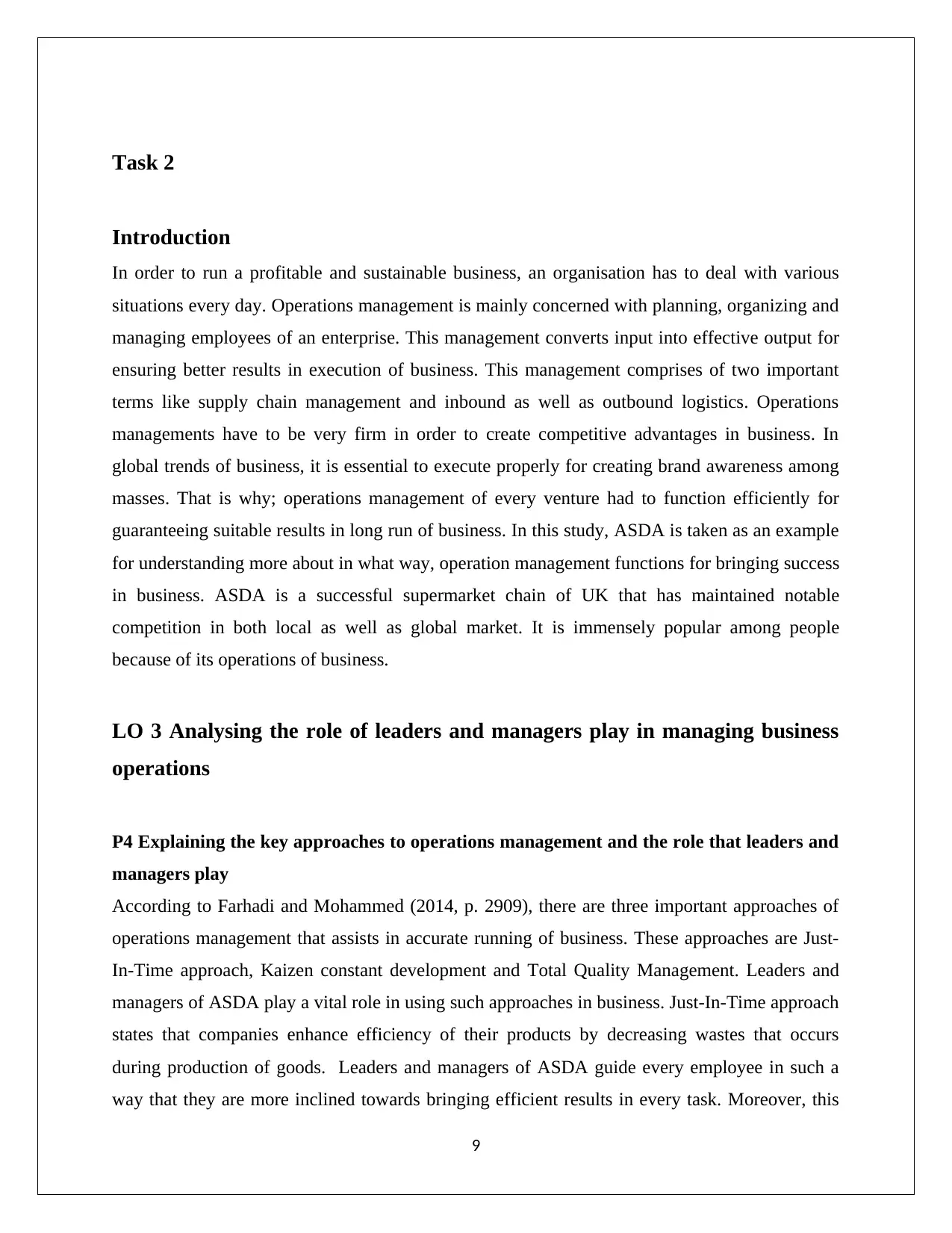
Task 2
Introduction
In order to run a profitable and sustainable business, an organisation has to deal with various
situations every day. Operations management is mainly concerned with planning, organizing and
managing employees of an enterprise. This management converts input into effective output for
ensuring better results in execution of business. This management comprises of two important
terms like supply chain management and inbound as well as outbound logistics. Operations
managements have to be very firm in order to create competitive advantages in business. In
global trends of business, it is essential to execute properly for creating brand awareness among
masses. That is why; operations management of every venture had to function efficiently for
guaranteeing suitable results in long run of business. In this study, ASDA is taken as an example
for understanding more about in what way, operation management functions for bringing success
in business. ASDA is a successful supermarket chain of UK that has maintained notable
competition in both local as well as global market. It is immensely popular among people
because of its operations of business.
LO 3 Analysing the role of leaders and managers play in managing business
operations
P4 Explaining the key approaches to operations management and the role that leaders and
managers play
According to Farhadi and Mohammed (2014, p. 2909), there are three important approaches of
operations management that assists in accurate running of business. These approaches are Just-
In-Time approach, Kaizen constant development and Total Quality Management. Leaders and
managers of ASDA play a vital role in using such approaches in business. Just-In-Time approach
states that companies enhance efficiency of their products by decreasing wastes that occurs
during production of goods. Leaders and managers of ASDA guide every employee in such a
way that they are more inclined towards bringing efficient results in every task. Moreover, this
9
Introduction
In order to run a profitable and sustainable business, an organisation has to deal with various
situations every day. Operations management is mainly concerned with planning, organizing and
managing employees of an enterprise. This management converts input into effective output for
ensuring better results in execution of business. This management comprises of two important
terms like supply chain management and inbound as well as outbound logistics. Operations
managements have to be very firm in order to create competitive advantages in business. In
global trends of business, it is essential to execute properly for creating brand awareness among
masses. That is why; operations management of every venture had to function efficiently for
guaranteeing suitable results in long run of business. In this study, ASDA is taken as an example
for understanding more about in what way, operation management functions for bringing success
in business. ASDA is a successful supermarket chain of UK that has maintained notable
competition in both local as well as global market. It is immensely popular among people
because of its operations of business.
LO 3 Analysing the role of leaders and managers play in managing business
operations
P4 Explaining the key approaches to operations management and the role that leaders and
managers play
According to Farhadi and Mohammed (2014, p. 2909), there are three important approaches of
operations management that assists in accurate running of business. These approaches are Just-
In-Time approach, Kaizen constant development and Total Quality Management. Leaders and
managers of ASDA play a vital role in using such approaches in business. Just-In-Time approach
states that companies enhance efficiency of their products by decreasing wastes that occurs
during production of goods. Leaders and managers of ASDA guide every employee in such a
way that they are more inclined towards bringing efficient results in every task. Moreover, this
9
⊘ This is a preview!⊘
Do you want full access?
Subscribe today to unlock all pages.

Trusted by 1+ million students worldwide
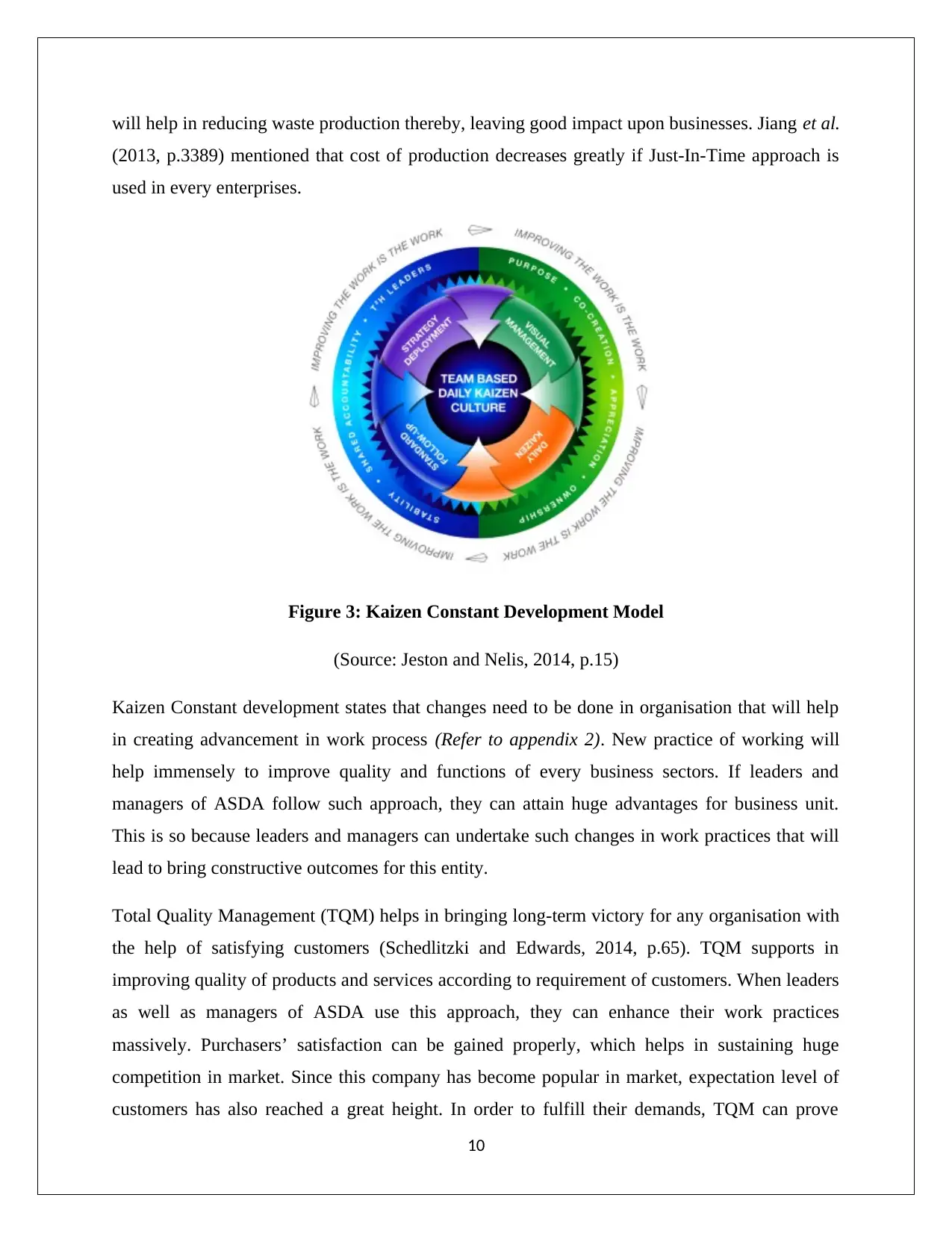
will help in reducing waste production thereby, leaving good impact upon businesses. Jiang et al.
(2013, p.3389) mentioned that cost of production decreases greatly if Just-In-Time approach is
used in every enterprises.
Figure 3: Kaizen Constant Development Model
(Source: Jeston and Nelis, 2014, p.15)
Kaizen Constant development states that changes need to be done in organisation that will help
in creating advancement in work process (Refer to appendix 2). New practice of working will
help immensely to improve quality and functions of every business sectors. If leaders and
managers of ASDA follow such approach, they can attain huge advantages for business unit.
This is so because leaders and managers can undertake such changes in work practices that will
lead to bring constructive outcomes for this entity.
Total Quality Management (TQM) helps in bringing long-term victory for any organisation with
the help of satisfying customers (Schedlitzki and Edwards, 2014, p.65). TQM supports in
improving quality of products and services according to requirement of customers. When leaders
as well as managers of ASDA use this approach, they can enhance their work practices
massively. Purchasers’ satisfaction can be gained properly, which helps in sustaining huge
competition in market. Since this company has become popular in market, expectation level of
customers has also reached a great height. In order to fulfill their demands, TQM can prove
10
(2013, p.3389) mentioned that cost of production decreases greatly if Just-In-Time approach is
used in every enterprises.
Figure 3: Kaizen Constant Development Model
(Source: Jeston and Nelis, 2014, p.15)
Kaizen Constant development states that changes need to be done in organisation that will help
in creating advancement in work process (Refer to appendix 2). New practice of working will
help immensely to improve quality and functions of every business sectors. If leaders and
managers of ASDA follow such approach, they can attain huge advantages for business unit.
This is so because leaders and managers can undertake such changes in work practices that will
lead to bring constructive outcomes for this entity.
Total Quality Management (TQM) helps in bringing long-term victory for any organisation with
the help of satisfying customers (Schedlitzki and Edwards, 2014, p.65). TQM supports in
improving quality of products and services according to requirement of customers. When leaders
as well as managers of ASDA use this approach, they can enhance their work practices
massively. Purchasers’ satisfaction can be gained properly, which helps in sustaining huge
competition in market. Since this company has become popular in market, expectation level of
customers has also reached a great height. In order to fulfill their demands, TQM can prove
10
Paraphrase This Document
Need a fresh take? Get an instant paraphrase of this document with our AI Paraphraser
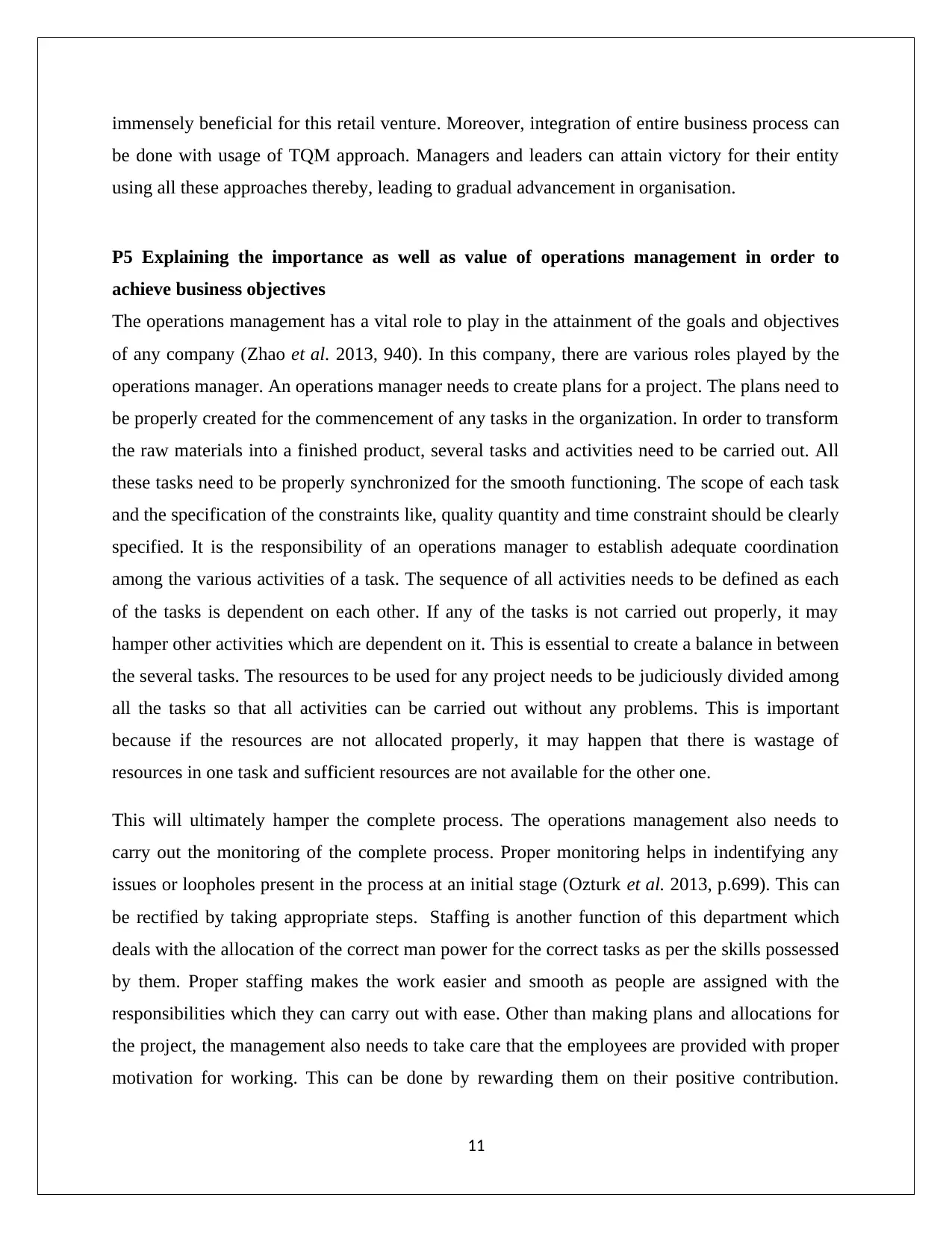
immensely beneficial for this retail venture. Moreover, integration of entire business process can
be done with usage of TQM approach. Managers and leaders can attain victory for their entity
using all these approaches thereby, leading to gradual advancement in organisation.
P5 Explaining the importance as well as value of operations management in order to
achieve business objectives
The operations management has a vital role to play in the attainment of the goals and objectives
of any company (Zhao et al. 2013, 940). In this company, there are various roles played by the
operations manager. An operations manager needs to create plans for a project. The plans need to
be properly created for the commencement of any tasks in the organization. In order to transform
the raw materials into a finished product, several tasks and activities need to be carried out. All
these tasks need to be properly synchronized for the smooth functioning. The scope of each task
and the specification of the constraints like, quality quantity and time constraint should be clearly
specified. It is the responsibility of an operations manager to establish adequate coordination
among the various activities of a task. The sequence of all activities needs to be defined as each
of the tasks is dependent on each other. If any of the tasks is not carried out properly, it may
hamper other activities which are dependent on it. This is essential to create a balance in between
the several tasks. The resources to be used for any project needs to be judiciously divided among
all the tasks so that all activities can be carried out without any problems. This is important
because if the resources are not allocated properly, it may happen that there is wastage of
resources in one task and sufficient resources are not available for the other one.
This will ultimately hamper the complete process. The operations management also needs to
carry out the monitoring of the complete process. Proper monitoring helps in indentifying any
issues or loopholes present in the process at an initial stage (Ozturk et al. 2013, p.699). This can
be rectified by taking appropriate steps. Staffing is another function of this department which
deals with the allocation of the correct man power for the correct tasks as per the skills possessed
by them. Proper staffing makes the work easier and smooth as people are assigned with the
responsibilities which they can carry out with ease. Other than making plans and allocations for
the project, the management also needs to take care that the employees are provided with proper
motivation for working. This can be done by rewarding them on their positive contribution.
11
be done with usage of TQM approach. Managers and leaders can attain victory for their entity
using all these approaches thereby, leading to gradual advancement in organisation.
P5 Explaining the importance as well as value of operations management in order to
achieve business objectives
The operations management has a vital role to play in the attainment of the goals and objectives
of any company (Zhao et al. 2013, 940). In this company, there are various roles played by the
operations manager. An operations manager needs to create plans for a project. The plans need to
be properly created for the commencement of any tasks in the organization. In order to transform
the raw materials into a finished product, several tasks and activities need to be carried out. All
these tasks need to be properly synchronized for the smooth functioning. The scope of each task
and the specification of the constraints like, quality quantity and time constraint should be clearly
specified. It is the responsibility of an operations manager to establish adequate coordination
among the various activities of a task. The sequence of all activities needs to be defined as each
of the tasks is dependent on each other. If any of the tasks is not carried out properly, it may
hamper other activities which are dependent on it. This is essential to create a balance in between
the several tasks. The resources to be used for any project needs to be judiciously divided among
all the tasks so that all activities can be carried out without any problems. This is important
because if the resources are not allocated properly, it may happen that there is wastage of
resources in one task and sufficient resources are not available for the other one.
This will ultimately hamper the complete process. The operations management also needs to
carry out the monitoring of the complete process. Proper monitoring helps in indentifying any
issues or loopholes present in the process at an initial stage (Ozturk et al. 2013, p.699). This can
be rectified by taking appropriate steps. Staffing is another function of this department which
deals with the allocation of the correct man power for the correct tasks as per the skills possessed
by them. Proper staffing makes the work easier and smooth as people are assigned with the
responsibilities which they can carry out with ease. Other than making plans and allocations for
the project, the management also needs to take care that the employees are provided with proper
motivation for working. This can be done by rewarding them on their positive contribution.
11
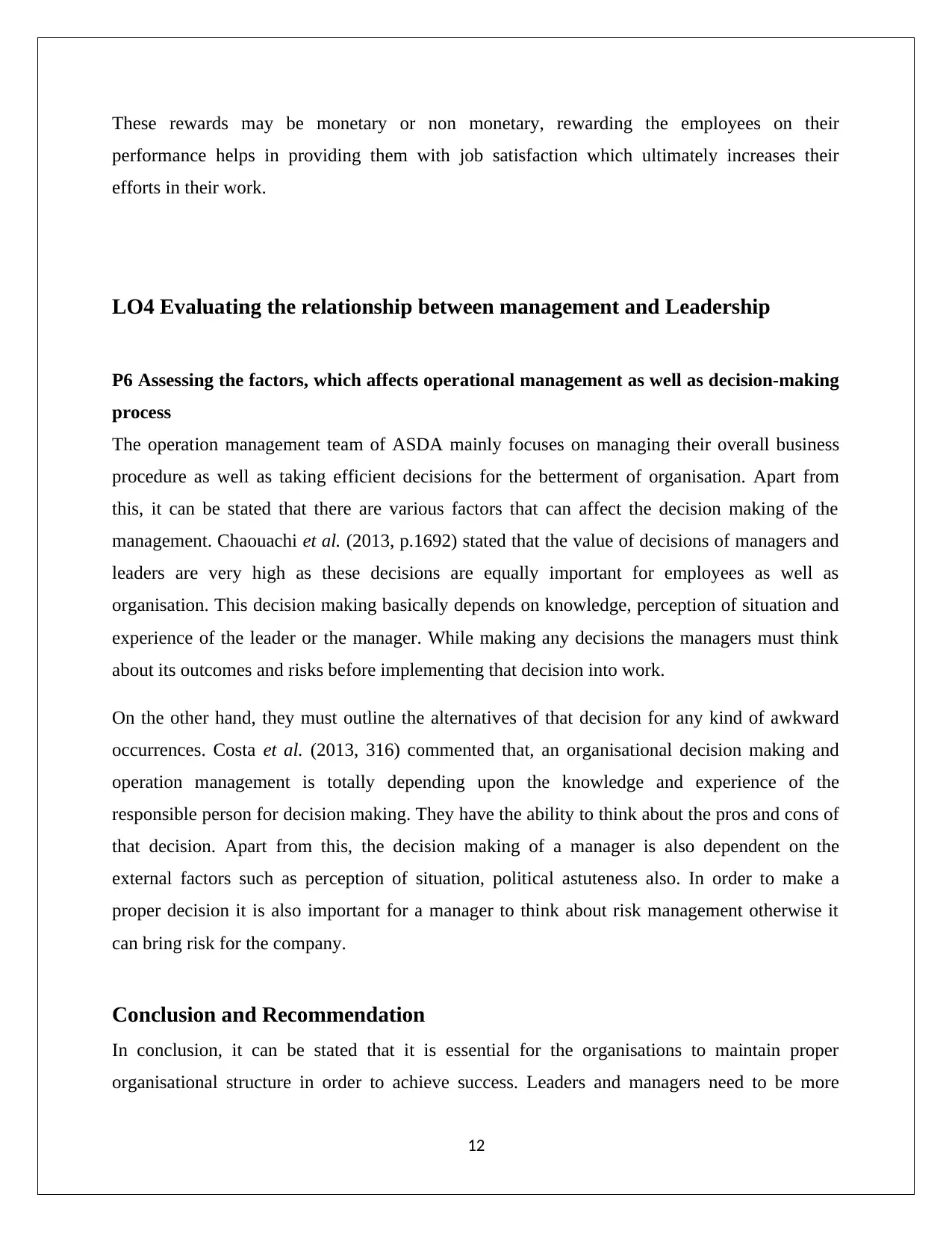
These rewards may be monetary or non monetary, rewarding the employees on their
performance helps in providing them with job satisfaction which ultimately increases their
efforts in their work.
LO4 Evaluating the relationship between management and Leadership
P6 Assessing the factors, which affects operational management as well as decision-making
process
The operation management team of ASDA mainly focuses on managing their overall business
procedure as well as taking efficient decisions for the betterment of organisation. Apart from
this, it can be stated that there are various factors that can affect the decision making of the
management. Chaouachi et al. (2013, p.1692) stated that the value of decisions of managers and
leaders are very high as these decisions are equally important for employees as well as
organisation. This decision making basically depends on knowledge, perception of situation and
experience of the leader or the manager. While making any decisions the managers must think
about its outcomes and risks before implementing that decision into work.
On the other hand, they must outline the alternatives of that decision for any kind of awkward
occurrences. Costa et al. (2013, 316) commented that, an organisational decision making and
operation management is totally depending upon the knowledge and experience of the
responsible person for decision making. They have the ability to think about the pros and cons of
that decision. Apart from this, the decision making of a manager is also dependent on the
external factors such as perception of situation, political astuteness also. In order to make a
proper decision it is also important for a manager to think about risk management otherwise it
can bring risk for the company.
Conclusion and Recommendation
In conclusion, it can be stated that it is essential for the organisations to maintain proper
organisational structure in order to achieve success. Leaders and managers need to be more
12
performance helps in providing them with job satisfaction which ultimately increases their
efforts in their work.
LO4 Evaluating the relationship between management and Leadership
P6 Assessing the factors, which affects operational management as well as decision-making
process
The operation management team of ASDA mainly focuses on managing their overall business
procedure as well as taking efficient decisions for the betterment of organisation. Apart from
this, it can be stated that there are various factors that can affect the decision making of the
management. Chaouachi et al. (2013, p.1692) stated that the value of decisions of managers and
leaders are very high as these decisions are equally important for employees as well as
organisation. This decision making basically depends on knowledge, perception of situation and
experience of the leader or the manager. While making any decisions the managers must think
about its outcomes and risks before implementing that decision into work.
On the other hand, they must outline the alternatives of that decision for any kind of awkward
occurrences. Costa et al. (2013, 316) commented that, an organisational decision making and
operation management is totally depending upon the knowledge and experience of the
responsible person for decision making. They have the ability to think about the pros and cons of
that decision. Apart from this, the decision making of a manager is also dependent on the
external factors such as perception of situation, political astuteness also. In order to make a
proper decision it is also important for a manager to think about risk management otherwise it
can bring risk for the company.
Conclusion and Recommendation
In conclusion, it can be stated that it is essential for the organisations to maintain proper
organisational structure in order to achieve success. Leaders and managers need to be more
12
⊘ This is a preview!⊘
Do you want full access?
Subscribe today to unlock all pages.

Trusted by 1+ million students worldwide
1 out of 17
Related Documents
Your All-in-One AI-Powered Toolkit for Academic Success.
+13062052269
info@desklib.com
Available 24*7 on WhatsApp / Email
![[object Object]](/_next/static/media/star-bottom.7253800d.svg)
Unlock your academic potential
Copyright © 2020–2025 A2Z Services. All Rights Reserved. Developed and managed by ZUCOL.





